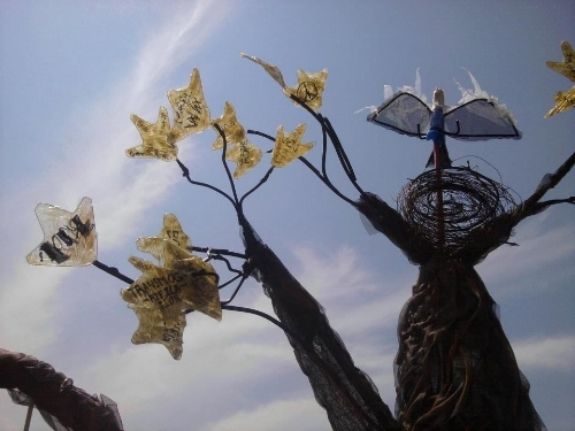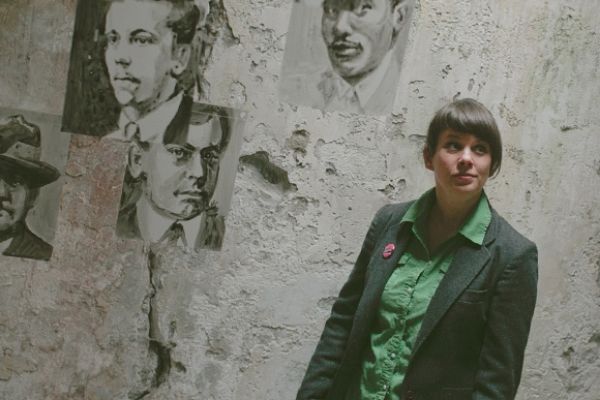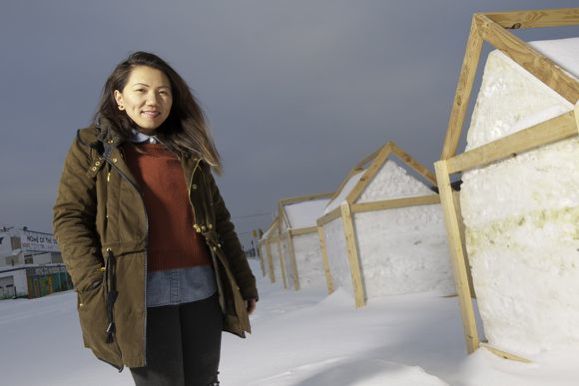In neighborhoods wracked by problems such as foreclosure, poverty and vacancy, artists are often seen as
developers of last resort, the first to move in and the first to get displaced as rents and property values inevitably escalate. Or as one arts advocate comments wryly, "We’ve all seen the SoHo movie, and we know how it ends.
Yet in the post-recession landscape, a number of artists and communities are choosing a different path. They’re integrating artists into community development strategies and using art to help transform neighborhoods. The goal is to spur growth, provide opportunities for artists and help existing residents prosper.
"We help communities tap into the power that artists provide, and to understand how they can use artists to help achieve their goals," says Laura Zabel, Executive Director of
Springboard for the Arts, a nonprofit organization with offices in St. Paul and Fergus, Minnesota whose mission is to cultivate vibrant communities through the arts.
"If there’s one thing we’ve learned from the past several years, it’s that the ways we’re trying to address issues in our community are not working well," she adds. "We need to think about them creatively -- artists are an asset that exists in every community."
Recently, Springboard launched
Creative Exchange, a national platform that shares stories of artists impacting their communities, promoting dialogue and conversation.
Highlighting an effective example of artist engagement, Zabel cites
Irrigate, a project that enlisted artists in placemaking efforts on the Central Corridor rail line in St. Paul. Irrigate employed over 350 artists in 150 projects, including painting a purple hippopotamus mural on the side of a building and hosting music in local restaurants.
 A "neo-bottle" tree in the Irrigate project
A "neo-bottle" tree in the Irrigate project"This has always been the work of artists," says Zabel. "Since the dawn of humanity, they’ve been creating work that engages and challenges communities. But there is a growing awareness among cities and communities and towns that, in the economic development and community development sectors, this is a really effective strategy."
In this story, we share a few highlights from Creative Exchange’s coverage. We invite you to check out the new platform, read the stories on the site and join the conversation.
Say hello to my little film festival: Miami
Filmmaker Lucas Leyva grew up in Miami and always thought of leaving. Then the recession changed everything. When he returned to the city after graduate school, he saw an authentic artistic culture taking root in his hometown. So, along with other filmmakers, he helped launch the
Borscht Film Festival to promote independent filmmaking culture in Miami.
"In the mainstream media, Miami is represented as cocaine, guns and fake breasts on South Beach," says Leyva, who serves as Creative Director of the festival. "But there is a more vibrant culture and more interesting narratives here than depicted in the media."
 Lucas Leyva of Borscht Corp.
Lucas Leyva of Borscht Corp.When the festival was created in 2004, there was no infrastructure in place to help young people who wanted to make original films. There was only one art house cinema in town, and while they hosted a film festival every year, it didn’t feature many local artists. The Borscht Festival has now been running for 10 years and grows every year.
"We never thought so many people would turn out to see these little films about the city made by these kids who weren’t really good at making films,” says Leyva. “We would sell out [screenings in these] underutilized spaces because the interest was there."
When the festival first started, the organizers would rent out the biggest theatre they could afford for one night only. Now the festival is a week-long affair -- last year they rented and sold out a 2,400 seat opera house to screen their main movies. In the past, organizers have watched with incredulity as tickets were scalped on the Internet.
The tremendous improvement in the quality and affordability of digital cameras has allowed the organizers at Borscht to help indie filmmakers find their voice. Now the team doesn't just screen films at their own festival; they actively help create them. Many of the films screened at the film festival are commissioned for the event and produced with festival assistance.
The festival also connects the dots among various facets of the burgeoning industry, helping filmmakers negotiate rates for rental houses, get insurance or find equipment.
Films co-produced by Borscht have now been shown at hundreds of film festivals around the world, including Sundance, and the group is beginning to offer regular programming. Borscht has received funding from the
Knight Foundation to create the
Miami Independent Cinema Fund and to help the festival transform Miami into a center for independent filmmaking.
The festival takes place every other year, and is coming up again in December. This year’s event will feature
Scarface Redux, a pastiche of the original '70s film. Filmmakers are remaking 15-second chunks of the film to ‘take it back’ and present a new, more authentic Miami. The results should be unexpected, possibly wacky and definitely fun, says Leyva.
"It always goes back to when we started as kids in high school," he explains, reflecting back on his beginnings and the desire to portray a more authentic version of his city’s culture through art. "Now there are kids in Miami making things that go around the world."
Exploring the outer limits of identity: Detroit
The Hinterlands is an experimental performance art group based in Detroit that explores the boundaries of neighborhoods, identity and art. Fittingly, they're located in NoHam -- a section of northern Hamtramck with a reputation as a borderland because of its non-native population.
In its current work, the group is not only exploring the concept of hinterlands through its art, but also actively participating in redeveloping this challenged community. The Hinterlands have leased a renovated property from
Power House Productions that was once a problem drug house, and they are using "Play House" as a studio and performance space.
"Hinterlands are the areas at the edge of the map just beyond civilization, but you can still see them on the map," explains Liza Bielby, who started The Hinterlands with Richard Newman. "We want to … get our audience to these unexplored places."
 Liza Bielby and Richard Newman of The Hinterlands
Liza Bielby and Richard Newman of The HinterlandsThanks to a grant from
ArtPlace America, Power House Productions has transformed the NoHam area into an ecosystem for artistic innovation -- the group has already renovated several houses within a six-block area and also built a sculpture park and skate park.
The Hinterlands troupe is using Play House as a laboratory to create and try out new work, host workshops and organize trainings. They also loan it out to other groups, such as the
Bangla School of Music, where musician, activist and scholar Akram Hossain teaches classical and contemporary Bangla music through singing, slide guitar and harmonium lessons.
Bielby describes The Hinterlands’ work as "a mesh between dance theatre and performance art." Past works have included the postmodern, psychedelic Wild West show
Manifest Destiny! (there was blood on the saddle), Dreamtigers, Drive-In Radio Theatre and
The Circuit, a madcap resurrection of Vaudeville in the Internet age. Over the years, the group has toured Kosovo, Canada, China and Macedonia.
The group also regularly offers free trainings in performance art open to anyone.
"Training is a way for us to get to these unexplored places of the Hinterlands," Bielby explains.
The Hinterlands' next major project will continue the group’s exploration of place and identity. The
Porous Borders Festival, which will be held in NoHam in May 2015, was
one of the winning projects in last year's Knight Arts Challenge. Held in their border neighborhood, the festival will, of course, examine the nature of borders in multiple ways.
Bielby is glad she returned to her home state.
"This was somewhere that [our work] could be sustainable and we could afford to live," she says. "We bought a house -- I never thought I'd be a homeowner -- and have a [studio] space and really awesome neighbors."
A collective approach to transformation: Philadelphia
The City of Philadelphia is known worldwide for its transformative
Mural Arts program. Perhaps lesser known are the small artistic engines chugging this city's arts renaissance forward.
One of those engines is
Grizzly Grizzly, a collective of six: Talia Greene, Michael Konrad, Ruth Scott Blackson, Mary Smull, Cindy Stockton Moore and Josh Weiss.
These artists are each involved in their own projects, but they also work on broader projects such as
Community Supported Art (CSA) and
CITYWIDE. CSA is a riff on the concept of community-supported agriculture, in which individuals purchase a share of locally grown food. These shares offer something entirely different -- namely, awesome art.
 Cindy Stockton Moore of Grizzly Grizzly
Cindy Stockton Moore of Grizzly GrizzlyCSA Philadelphia is one of two such programs that launched in 2012. Grizzly Grizzly, in collaboration with neighboring collective
Tiger Strikes Asteroid, and with support from the Knight Foundation, Springboard for the Arts and the city, identified a range of artwork, from sculptural installations and paintings to wearable paper art and ceramics. In that CSA, there were nine artists featured and three separate pickups; individual shares cost $350.
CITYWIDE brought together 26 different collectives and artist-run spaces across the city to promote the Philly art scene.
"We're insiders; we know all these great little spaces doing this great programming within their communities,” says Grizzly Grizzly member Cindy Stockton Moore. "We bonded together as a larger group and were able to publicize everyone as a whole."
CITYWIDE contracted trolleys to take visitors around to different gallery locations, exposing more Philadelphians to the city’s artists and linking various arts districts together.
Stockton Moore says being part of Grizzly Grizzly and the city’s art scene has allowed her to connect with her community. "This would not have happened if it weren't for Grizzly Grizzly," she explains.
Giving voice through art and community: St. Paul
There are roughly 30,000 Hmong-Americans living in Saint Paul, Minnesota today, more than any other city in the country. The Hmong are an Asian ethnic group believed to have originated in the mountainous Yangtze River basin of southern China. During the Vietnam War, Hmong people living in Laos were trained by the CIA to fight communist forces, and afterwards faced mass genocide by the government, forcing them to seek political asylum.
The Hmong have their own language, religion, distinct culture and traditions. They have a rich oral history passed down to each generation through legends, ritual ceremonies, textile art and story cloths, yet they have little written history predating modern times.
Oskar Ly is a Hmong French American in Saint Paul. She grew up in a traditional household where her mother was always sewing, and as she got older Ly decided to make her own fashions. Today she is a fashion designer, hair and makeup artist, and singer-songwriter who fosters and promotes Hmong arts and talent in Saint Paul.
 St. Paul Hmong artist Oskar Ly at "Home is ... "
St. Paul Hmong artist Oskar Ly at "Home is ... "For Ly, creating music is an opportunity to celebrate and share Hmong culture, but also to navigate between multiple cultural identities and try to reconcile her ethnic heritage with her western upbringing. As a second generation immigrant, she is inspired by more than Hmong music; she also draws from pop, folk, hip-hop and many other genres.
"Art is a way to tell our experiences and share our stories," she says. "With the Hmong community, there are not enough narratives out there to paint a portrait of where it is going or how it is changing … With the arts, people are in control of how they tell their stories."
Ly has been a leader in the organization and an ambassador for Hmong arts for several years, exploring Hmong culture and community-building through music and fashion. Saint Paul is home to the first Hmong arts center in the country, the
Center for Hmong Arts and Talent (CHAT). While the Hmong have no history of written language, their history and culture is often worn directly on the body in bright intricate costumes.
Ly also works with
Shades of Yellow, the only Hmong LGBT organization in the country, and helped to organize a Queer New Year event.
"Much like in the Asian community, there is a lot of homophobia deeply ingrained in [the Hmong] community," she says.
By working with different arts organizations and fostering relationships with other artists and arts advocates, Ly has become an arts organizer. Her most recent idea has taken her off the runway and put her on the streets -- leading the highly visible project
ARTIFY, a placemaking project that transformed the blighted corner of Hamline and University, the site of a former car dealership that had been vacant for 10 years, into a public art showcase.
She worked with local artists to create and share on the site, and create a sense of place and neighborhood pride. The project had the theme "Home is…" which encouraged artists to reinterpret the concepts of home, neighborhood and community.
"[I've been] hearing from community members their stories on how they used to experience the site and how they've grown a sense of pride about the site instead of it being just another empty spot," she says.
For more stories of artists sparking change in their communities, visit Creative Exchange at http://springboardexchange.org and join the conversation on Facebook and Twitter at @CreateExchange.
Nicole Rupersburg is Project Editor of Creative Exchange, and also covers arts, culture, food, and travel all throughout America. Follow her on Twitter @ruperstarski and Instagram @eatsdrinksandleaves.
Lee Chilcote is Editorial Director with Issue Media Group and a freelance writer in Cleveland. He writes about urban redevelopment, placemaking and the future of cities. Follow him on Twitter @leechilcote.